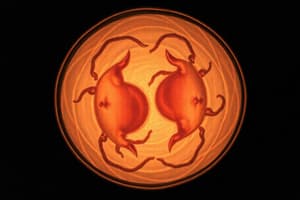Podcast
Questions and Answers
What is the primary purpose of mitosis in organisms?
What is the primary purpose of mitosis in organisms?
- To break down old cells
- To produce new cells for growth, repair, and reproduction (correct)
- To initiate the process of DNA replication
- To increase genetic variation
What occurs to chromosomes just before a cell divides?
What occurs to chromosomes just before a cell divides?
- They double in number and then dissolve
- They become visible and condense (correct)
- They disappear completely
- They split into multiple fragments
During which stage of mitosis do chromosomes line up along the equator of the cell?
During which stage of mitosis do chromosomes line up along the equator of the cell?
- Telophase
- Anaphase
- Metaphase (correct)
- Prophase
What is the role of RNA during the process of DNA function?
What is the role of RNA during the process of DNA function?
What happens to DNA during the process of DNA replication?
What happens to DNA during the process of DNA replication?
What is a chromatid?
What is a chromatid?
How many new cells are produced from one parent cell after mitosis?
How many new cells are produced from one parent cell after mitosis?
Why is it necessary for a cell to duplicate its chromosomes before undergoing mitosis?
Why is it necessary for a cell to duplicate its chromosomes before undergoing mitosis?
What is a key difference between RNA and DNA?
What is a key difference between RNA and DNA?
What type of cell results from fertilization?
What type of cell results from fertilization?
In Meiosis, how many chromosomes do the daughter cells have in humans compared to the parent cell?
In Meiosis, how many chromosomes do the daughter cells have in humans compared to the parent cell?
During which stage of Meiosis do homologous chromosomes line up along the equator of the cell?
During which stage of Meiosis do homologous chromosomes line up along the equator of the cell?
Which of the following accurately describes a haploid cell?
Which of the following accurately describes a haploid cell?
What is the main function of Meiosis in multicellular organisms?
What is the main function of Meiosis in multicellular organisms?
What is the end product of Mitosis?
What is the end product of Mitosis?
Which statement is true about the daughter cells produced in Meiosis compared to those produced in Mitosis?
Which statement is true about the daughter cells produced in Meiosis compared to those produced in Mitosis?
What do isotopes of an element differ in?
What do isotopes of an element differ in?
What is the process of radioactive decay used for in geology?
What is the process of radioactive decay used for in geology?
What does the fossil record primarily provide evidence of?
What does the fossil record primarily provide evidence of?
What is the law of superposition in geology?
What is the law of superposition in geology?
How is half-life defined in the context of radioactive dating?
How is half-life defined in the context of radioactive dating?
Which of the following is a characteristic of evolution?
Which of the following is a characteristic of evolution?
What comprises the primary evidence for evolution according to paleontology?
What comprises the primary evidence for evolution according to paleontology?
What defines a scientific theory?
What defines a scientific theory?
What primarily holds a galaxy together?
What primarily holds a galaxy together?
What describes plasma?
What describes plasma?
What initiated the formation of the Sun?
What initiated the formation of the Sun?
What are the two opposing forces that maintain a star's structure?
What are the two opposing forces that maintain a star's structure?
What happens to matter within a dying star that can lead to a black hole?
What happens to matter within a dying star that can lead to a black hole?
What type of galaxy is the Milky Way classified as?
What type of galaxy is the Milky Way classified as?
What is the role of gravity in the formation of stars from nebulae?
What is the role of gravity in the formation of stars from nebulae?
How far is the Sun from the center of the Milky Way galaxy?
How far is the Sun from the center of the Milky Way galaxy?
What does comparative anatomy study?
What does comparative anatomy study?
What are homologous structures?
What are homologous structures?
How have horse limbs adapted over time?
How have horse limbs adapted over time?
What is the primary characteristic of vestigial organs?
What is the primary characteristic of vestigial organs?
What evidence supports the theory of evolution according to homologous structures?
What evidence supports the theory of evolution according to homologous structures?
Which of the following is true regarding biogeography?
Which of the following is true regarding biogeography?
Which animal is not typically found as a herbivore in Australia?
Which animal is not typically found as a herbivore in Australia?
Which of the following is considered a homologous structure?
Which of the following is considered a homologous structure?
Study Notes
Cell Division
- The body needs new cells for growth, repair, and reproduction.
- Cell division is the process of producing new cells from old cells.
- Mitosis is the type of cell division that makes animals and plants grow and replaces old and damaged cells.
- In mitosis, a parent cell divides into two identical daughter cells.
- Before a cell divides, it must duplicate all its chromosomes.
Chromosomes
- Chromosomes are long, thin strands that condense and become shorter and thicker before cell division.
- Each chromosome duplicates into two strands called chromatids, joined at the centromere.
Stages of Mitosis
- Stage 1: Two pairs of chromosomes are visible.
- Stage 2: Chromosomes are doubled.
- Stage 3: Chromosomes line up along the cell's equator.
- Stage 4: Chromosomes separate and move to the cell's ends.
- Stage 5: Membranes form to produce two new cells.
DNA Replication
- DNA replication is the copying of the entire DNA inside a cell before it divides.
- It results in two identical DNA molecules, each with an original strand and a new strand.
- The parent DNA molecule "unzips" at one end, and complementary bases attach to both strands.
DNA Function
- DNA stores information as a series of nucleotides.
- A long series of nucleotides forms a gene, which makes one protein.
- Proteins are the building blocks of our bodies and control growth and aging.
RNA
- RNA is a carrier molecule that copies the DNA code.
- It has a different sugar (ribose) and one of the bases is different (U instead of T).
- RNA is a single strand of nucleotides.
Meiosis
- Meiosis is cell division in sexually reproducing organisms that reduces the number of chromosomes in gametes (sex cells).
- Gametes are egg and sperm cells.
- Fertilization is the fusion of gametes, creating a zygote.
- The zygote divides by mitosis to become an embryo and then a fetus.
Stages of Meiosis
- Stage 1: Two pairs of chromosomes are visible.
- Stage 2: Chromosomes are doubled and attached at the centromere.
- Stage 3: Homologous chromosomes line up along the cell's equator.
- Stage 4: One chromosome from each pair moves to the cell's ends.
- Stage 5: Chromosomes line up along the equator of each new cell.
- Stage 6: Chromosomes separate and move to the ends of each cell.
- Stage 7: Membranes form to produce four daughter cells.
Diploid and Haploid Cells
- A diploid cell has a full set of chromosomes (two of each chromosome).
- A haploid cell has half a set of chromosomes (one of each homologous pair).
Mitosis vs Meiosis
| Characteristic | Mitosis | Meiosis |
|---|---|---|
| Type of cells produced | Body cells | Sex cells |
| Function | Growth and repair | Reproduction |
| Number of stages | 1 | 2 |
| Number of daughter cells | 2 | 4 |
| Number of chromosomes in parent cells (human) | 46 | 46 |
| Number of chromosomes in daughter cells (human) | 46 | 23 |
| Are daughter cells identical to parent cells? | Yes | No |
Relative Dating
- Sedimentary rocks form in layers called strata.
- Fossils are the same age as the rocks they are found in.
Radioactive Dating
- Isotopes are atoms of an element with different numbers of neutrons, so they have different atomic masses.
- Radioactive elements decay at a known rate.
- Scientists measure decayed elements to estimate the age of rocks.
Half-Life
- The half-life is the time it takes for half of a radioactive sample to decay.
- Examples of radioactive isotopes used for dating fossils include Carbon 14 and Potassium 40.
The Fossil Record
- The fossil record is incomplete, as only a tiny fraction of past life has been fossilized.
- It provides evidence of the following:
- A vast number of species have evolved from early life forms.
- Existing organisms result from changes in pre-existing species lines.
- New species have formed from pre-existing ones.
- Life forms have developed at slow and uneven rates.
- Environmental conditions have changed over time.
- Organisms have appeared, become abundant, and disappeared.
Evolution
- Evolution is the slow change in a population of living things over many generations.
- The theory of evolution states that life on Earth has changed over time, with different species developing from a common ancestor.
Scientific Theory
- A scientific theory is an evidence-based explanation for a set of observed facts.
Types of Evidence for Evolution
- Palaeontology: The fossil record provides direct evidence of evolution, showing continual change and diversification of early life forms.
- Law of Superposition: Sedimentary rocks are deposited on top of each other, with older layers lower down.
- Comparative Anatomy: Studying similarities and differences in body structures helps determine evolutionary relationships.
- Pentadactyl Limb: Vertebrate limbs (e.g., seal flipper, cat paw, bat wing, human hand) have the same bone structure, showing adaptation to different functions.
- Homologous Structures: Similar structures in different organisms suggest a common ancestor.
- Vestigial Organs: Structures with no current function (e.g., human appendix) suggest they were functional in ancestors.
Biogeography
- Continents have characteristic life forms due to isolation and adaptation to specific environments.
The Milky Way
- The Milky Way is a spiral galaxy containing billions of stars, dust, and gas.
- The Sun is located on one of the spiral arms, about 25,000 light-years from the center.
Gravity
- Gravity is the attractive force between any two objects in the universe.
- It is a weak force, but becomes significant when masses are incredibly large.
Stars and Gravity
- Gravity causes immense pressure within stars, leading to nuclear fusion of hydrogen atoms into helium.
- Stellar structure is determined by the balance between inward gravity and outward radiation pressure.
Nebulae
- Nebulae are clouds of gas and dust where stars are formed.
- The Sun formed from a solar nebula, a cloud of gas and dust.
- A supernova explosion likely initiated the collapse of the solar nebula, leading to the formation of the Sun and planets.
Studying That Suits You
Use AI to generate personalized quizzes and flashcards to suit your learning preferences.
Related Documents
Description
Explore the fascinating process of cell division, focusing on mitosis and the stages involved. This quiz covers the roles of chromosomes and DNA replication, essential for growth and repair in organisms. Test your understanding of how cells reproduce and function in living beings.





